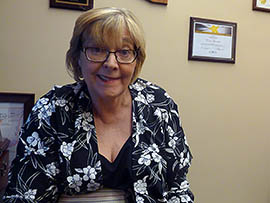Cronkite News has moved to a new home at cronkitenews.azpbs.org. Use this site to search archives from 2011 to May 2015. You can search the new site for current stories.
For many Arizonans, drug abuse starts with a prescription, not a syringe
PHOENIX – For Doris Goodale’s grown daughter, drug addiction didn’t begin with a party and a syringe. It was a doctor and a pill.
When Stephanie Goodale suffered from severe kidney issues, the doctor gave her an extended prescription to opioid pain pills, leading to addiction, said Goodale, a Republican state representative from Kingman.
When the prescription ended, Stephanie started using heroin as a cheaper alternative, her mother said. Soon after, authorities arrested her in May 2012, resulting in a prison term for heroin trafficking.
“When their treatment is over, their broken arm is fixed and they don’t need the pain pills any more; they’re addicted and the doctor sends them home,” Doris Goodale said. “And the next thing you know, they’re addicted so they go out and they become a street criminal because they’re out trying to buy drugs.”
In response to her daughter’s struggle, Goodale said she wants to see more done in Arizona to prevent patients from becoming addicted to opioid pain pills.
“So many treatment centers talk about their clients who have become addicted fall under a doctor’s care, and that to me is very concerning,” she said.
While Goodale hasn’t introduced legislation on the subject this session aimed at curbing prescription drug abuse, two bills by Sen. Kelli Ward, R-Lake Havasu City, are advancing.
SB 1296 would require health care providers contracted with the Arizona Health Care Cost Containment System to intervene if a person gets 10 prescriptions for controlled substances in a three-month period. SB 1297 would require doctors and pharmacists contracted with AHCCCS to check a database that tracks opioid prescriptions before giving a patient access to those drugs.
Both bills received Senate approval and were awaiting action by the House.
“Arizona has a prescription drug problem,” Ward said in an email. “Every year we prescribe enough controlled substances to medicate every adult Arizonan around the clock for two weeks.”
Opioids relieve chronic pain but also cause intense dependency, said Dr. Andrew Kolodny, president of the national group Physicians for Responsible Opioid Prescribing.
“When you treat chronic, non-cancer pain with long-term opioids, you wind up harming far more patients than you help,” Kolodny said.
According to recent data from the Trust for America’s Health, about 18 out of 100,000 Arizonans died from drug overdoses in 2010, ranking the state sixth in the U.S.
To counter opioid addiction, Arizona already has laws that: allow physicians to add to and check a database when they prescribe opioids; make obtaining a prescription by deceit a misdemeanor; and require doctors to physically examine patients before writing prescriptions for controlled substances.
In 2012, the U.S. Centers for Disease Control and Prevention declared prescription drug addiction a nationwide epidemic, calling it the fastest-growing drug problem in the country.
Richard Hamburg, deputy director of the Trust for America’s Health, said more people need to be educated about what he calls a public health crisis.
“This is a problem that’s grown so quickly that there’s not yet a truly excessive amount of research on the most effective strategies,” Hamburg said.
Sheila Sjolanber, assistant director of public health prevention services at the Arizona Department of Health Services, said Arizonans are beginning to realize the dangers of opioids. Many have taken steps such as disposing of unused pills properly and considering the risks of addiction while on heavy duty medication.
“There’s a lot of public awareness around that now that there didn’t used to be,” Sjolanber said.
She added that overdose rates in Arizona have actually decreased in the last two years. In the next month, she said, the Department of Health Services will host a summit to develop statewide guidelines for opioid prescriptions.
Phillip Stevenson, director of statistical analysis for the Arizona Criminal Justice Commission, said the commission has worked with numerous agencies for two years on the Arizona Prescription Drug Misuse and Abuse Initiative, which uses strategies like law enforcement training and prescription drop-off locations.
“It’s not just an enforcement approach, it’s not just a prevention approach, it’s more than that,” he said.
The initiative reduced the prescription of opioids in Yavapai County by 10.9 percent and in Pinal County by 5.9 percent, Stevenson said.
Kolodny, from Physicians for Responsible Opioid Prescribing, said American culture has adapted to using pills as an instant solution for complex health problems.
In the 1990s drug companies ran campaigns that offered opioids to doctors as a quick, easy fix for patients with chronic pain, he said, overshadowing what he called more effective long-term treatments like physical therapy or over-the-counter options such as Tylenol.
“They wanted the medical community to prescribe it aggressively for these common long-term problems. And so they launched a campaign telling doctors we shouldn’t worry about addiction,” Kolodny said.
Michael Yasinski, a psychiatrist based in Scottsdale who has treated patients with prescription drug addiction for five years, said opioid prescriptions have become a problem because doctors are too busy to provide the care they used to.
“I don’t think doctors have the same amount of time, nor the intimate relationship with the patient,” Yasinski said. “They just kind of more automatically (prescribe) as patients kind of become numbers.”
Goodale’s daughter was released from prison in November and now attends addiction classes almost every day, Doris Goodale said.
“She’s doing very, very well,” Goodale said.
But many Arizonans still get addicted because of prescriptions from their doctors, she said, adding that an addiction assessment could be conducted before the patient is taken off painkillers.
“If the person is addicted then the doctor needs to work with that person to find an avenue for getting some help,” she said.








